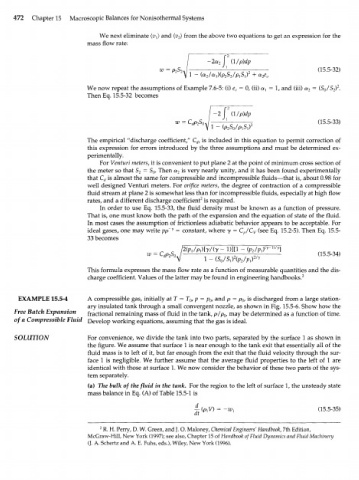Page 492 - Bird R.B. Transport phenomena
P. 492
472 Chapter 15 Macroscopic Balances for Nonisothermal Systems
We next eliminate ^) and (v ) from the above two equations to get an expression for the
2
mass flow rate:
-2a 2 Г (l/p)dp
w = p 2 S 2 (15.5-32)
- (a 2 /'a ] )(p 2 S 2 /PiS]) 2 + a 2 e v
2
We now repeat the assumptions of Example 7.6-5: (i) e = 0, (ii) a } = 1, and (iii) a 2 = (S /S ) .
v
0
2
Then Eq. 15.5-32 becomes
-2 \ (l/p)dp
w = C d p 2 S 0 . (15.5-33)
1 -
The empirical "discharge coefficient/' C , is included in this equation to permit correction of
d
this expression for errors introduced by the three assumptions and must be determined ex-
perimentally.
For Venturi meters, it is convenient to put plane 2 at the point of minimum cross section of
the meter so that S = S . Then a is very nearly unity, and it has been found experimentally
2
o
2
that C is almost the same for compressible and incompressible fluids—that is, about 0.98 for
d
well designed Venturi meters. For orifice meters, the degree of contraction of a compressible
fluid stream at plane 2 is somewhat less than for incompressible fluids, especially at high flow
rates, and a different discharge coefficient 2 is required.
In order to use Eq. 15.5-33, the fluid density must be known as a function of pressure.
That is, one must know both the path of the expansion and the equation of state of the fluid.
In most cases the assumption of frictionless adiabatic behavior appears to be acceptable. For
y
ideal gases, one may write pp~ = constant, where у = C /C v (see Eq. 15.2-5). Then Eq. 15.5-
p
33 becomes
w = C p S { (15.5-34)
2
d
2
- (S /S,) (p / ) 2/y
0 2 Pl
This formula expresses the mass flow rate as a function of measurable quantities and the dis-
charge coefficient. Values of the latter may be found in engineering handbooks. 2
EXAMPLE 15.5-4 A compressible gas, initially at T = T , p = p , and p = p , is discharged from a large station-
o
0
0
ary insulated tank through a small convergent nozzle, as shown in Fig. 15.5-6. Show how the
Free Batch Expansion fractional remaining mass of fluid in the tank, p/p , may be determined as a function of time.
0
of a Compressible Fluid Develop working equations, assuming that the gas is ideal.
SOLUTION For convenience, we divide the tank into two parts, separated by the surface 1 as shown in
the figure. We assume that surface 1 is near enough to the tank exit that essentially all of the
fluid mass is to left of it, but far enough from the exit that the fluid velocity through the sur-
face 1 is negligible. We further assume that the average fluid properties to the left of 1 are
identical with those at surface 1. We now consider the behavior of these two parts of the sys-
tem separately.
(a) The bulk of the fluid in the tank. For the region to the left of surface 1, the unsteady state
mass balance in Eq. (A) of Table 15.5-1 is
4-(piV)= -W, (15.5-35)
2
R. H. Perry, D. W. Green, and J. O. Maloney, Chemical Engineers' Handbook, 7th Edition,
McGraw-Hill, New York (1997); see also, Chapter 15 of Handbook of Fluid Dynamics and Fluid Machinery
(J. A. Schertz and A. E. Fuhs, eds.), Wiley, New York (1996).

